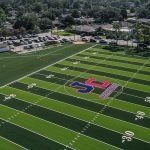S&P Global Ratings lowered its outlook on Foot Locker to negative from stable as the sneaker chain lowered its full-year guidance due to a combination of inflationary pressures, higher-than-expected discounting initiatives and weak consumer spending.
The rating agency affirmed Foot Locker’s ‘BB+’ issuer credit rating on the company’s senior unsecured notes with a ‘3’ recovery rating.
S&P said the negative outlook reflected the risk that current operating challenges and lower consumer discretionary spending on footwear and apparel could lead to weaker profitability and sustained elevated leverage.
S&P said in its analysis, “Foot Locker’s operating performance will continue to be pressured in 2023 amid a challenging economic environment. Although moderating from peak levels, we expect elevated inflationary pressures will continue to drive lower consumer discretionary demand as consumers remain pressured and prioritize nondiscretionary spending. For the first quarter ended April 29, 2023, Foot Locker’s total revenues decreased more than 11 percent year over year. Its S&P Global Ratings-adjusted EBITDA declined roughly 390 basis points (bps) toward the low 16 percent area from the high-19 percent area in the prior year period as consumer demand continued to soften in the quarter and inventory levels remained elevated at 25 percent above last year’s levels. As a result, the company will likely pursue a more aggressive discounting strategy extending into the back half of the year, pressuring margins in the near term. However, we believe that it will reduce excess inventory throughout the course of the year and improve its working capital position.
“Although Foot Locker’s Nike reset will likely pressure results in the short-run, its repositioning of the Champs Sports banner, focus on expanding into more off-mall locations, and greater vendor mix diversification will partially offset this over the long term. As of the first quarter of 2023, Foot Locker’s sales mix was still predominantly reliant on Nike, with 65 percent of sales coming from the brand. We expect this to come down to roughly 55 percent to 60 percent by 2026 as the company continues to make strides in diversifying its vendor base. In addition, off-mall locations represented roughly 35 percent of total square footage in North America as of the first quarter and have outperformed mall-based stores on average.
“Foot Locker’s digital penetration has remained relatively unchanged year over year, comprising roughly 16 percent of total sales. However, we expect management’s initiative to invest in new technology infrastructure and expand its omnichannel capabilities to result in positive sales growth over the long term, given increasing consumer preferences towards online shopping. As certain consumers shift away from in-person shopping at traditional brick-and-mortar stores, Foot Locker’s ability to offer a differentiated and seamless customer experience—both in-store and online—will be essential to its long-term success.
“We forecast S&P Global Ratings-adjusted leverage to be in the mid-2x area this year, moderating toward the low-2x area in 2024. We expect Foot Locker’s leverage to rise to the mid-2x area in fiscal 2023, compared with 1.8x at the end of fiscal 2022. This is driven by S&P Global Ratings-adjusted EBITDA contracting more than 300 bps in the quarter from weakened consumer demand and deeper markdowns, which we expect to continue through the remainder of the year. As a result of these operating pressures, elevated costs, and ongoing heavy growth capital expenditure (capex), we estimate Foot Locker will generate negative free operating cash flow (FOCF) of roughly $89 million in fiscal 2023. Given our expectation for weakening credit protection measures and softer cash flow generation, we revised our financial risk profile assessment to intermediate from modest.
“Foot Locker has adequate liquidity with no near-term maturities. As of April 29, 2023, Foot Locker had $313 million of balance sheet cash and an undrawn balance on its $600 million asset-based lending (ABL) facility. Although we expect Foot Locker to maintain its dividend, we do not anticipate meaningful share repurchases this year as management prioritizes its cash balances. Foot Locker has no near-term maturities, with an ABL facility maturing in 2025 and $400 million of senior unsecured notes maturing in 2029. We anticipate current debt levels to remain relatively unchanged over the next 12 months.
“The negative outlook reflects the risk of a downgrade if the company does not meaningfully improve its operating performance and cash flow generation over the next 12 months.
“We could lower our ratings on Foot Locker if the company’s initiatives to maneuver its reset of Nike and reposition Champs Sports do not demonstrate meaningful progress. Under such a scenario, we would expect limited traffic improvement and insignificant margin expansion to result in stagnant operating cash flow generation. Specifically, a downgrade would be preceded by our expectation for adjusted funds from operations (FFO) to debt to remain below 40 percent on a sustained basis and adjusted discretionary cash flow (DCF) to debt to remain below 15 percent.
“We could revise the outlook on Foot Locker to stable if we expect a significant rebound in operating performance and meaningfully improved traffic. In this scenario, we would expect adjusted FFO to debt to be sustained above 40 percent and adjusted DCF to debt to be sustained above 15 percent.”














